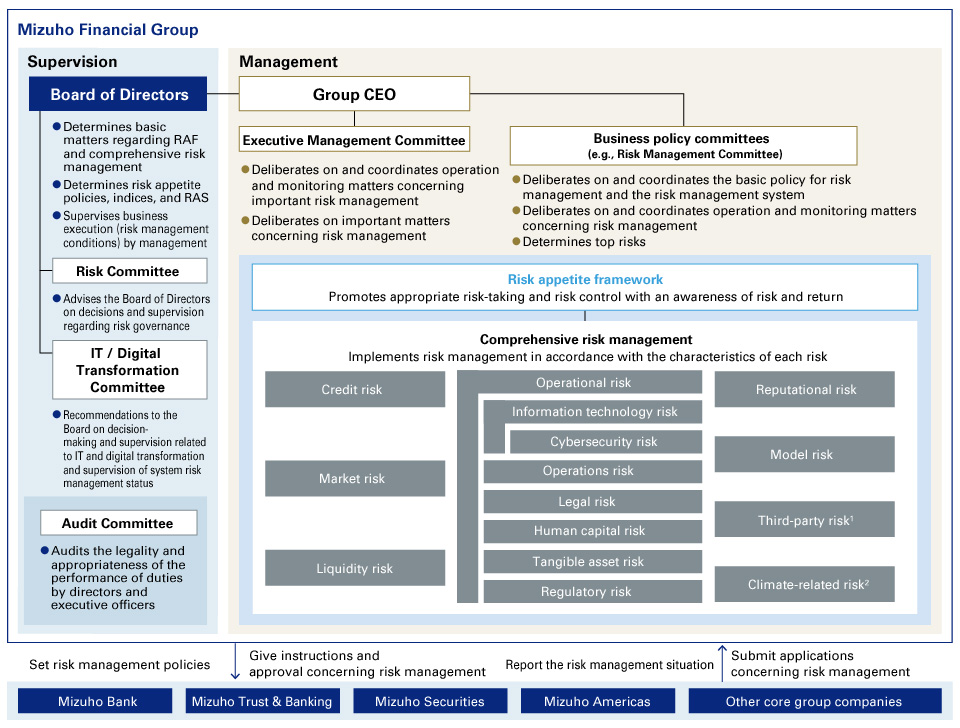Risk Governance
Basic approach
To fulfill our responsibility as a global financial institution, the Mizuho group integrates the implementation of risk management with the execution of business strategy and financial strategy through our risk appetite framework, and we advance appropriate risk-taking and risk control in order to grow and develop sustainably together with customers, economies, and society as a whole.
When selecting our top risks for fiscal 2024, in addition to our risk perception with regard to the macro-environment and monetary policy direction in Japan and globally, we discussed the increased focus of society on environmental and social issues such as climate change, loss of nature, and human rights violations, as well as the risks posed by generative AI. We have addressed each top risk with a variety of controls, three of which we will focus on here as they relate to the core topics of the medium-term business plan.
First, our readiness for an increasingly unpredictable global financial and economic environment. With regard to credit risk, we simulate and examine the impact of rising interest rates on the macroeconomy and corporate earnings, and take risks based on an appropriate risk-return calculation. In addition, despite the volatile market environment, with the yen at historic lows against the dollar, we are monitoring trends in different countries’ financial policies and working to control market and liquidity risks with a forward-looking approach, drawing on lessons learned from the market volatility caused by rapid interest rate hikes in the US and Europe in recent years.
Second is global risk management. The acquisition of Greenhill in the Americas is an example of our group's expansion of the global CIB business. We are also strengthening our risk management systems in the Americas, EMEA, and APAC to provide banking and securities functions globally.
Finally, we are strengthening our corporate foundations. We must improve readiness in areas of growing risk, such as cybersecurity, and also be vigilant against new risks due to the rapid spread of AI. In order to provide stable financial services, we will strive to improve risk management also from the perspective of operational resilience.
In the context of unprecedented uncertainty around the globe, this will be an important year for us to assess the global environment in a forward-looking manner under our risk appetite framework, and to execute our strategy through flexible and appropriate risk-taking and risk control. We will comprehensively assess and evaluate risks and opportunities in order to proceed with appropriate risk management on a group and global basis.

Risk appetite framework (RAF)
We have positioned our RAF as the corporate management framework to execute risk-taking in a manner that is consistent with our risk appetite. Risk appetite refers to the types and levels of risk that we will accept in order to implement our business and financial strategies. Through our RAF, we manage strategy and risk in an integrated manner and aim to achieve the optimal risk and return through appropriate risk-taking and risk control.
In the actual implementation of our RAF, the Board of Directors determines basic matters concerning the RAF and also decides on a risk appetite statement (RAS), which documents the RAF's management system and Mizuho's risk appetite. Operations are supervised based on the Board’s decisions. In addition, the Risk Committee, which advises the Board of Directors, provides advice to the Board on matters concerning the RAF and related topics. In business operations, the Group CRO, Group CFO, and Group CSO provide assistance overseen by the Group CEO, and implement business strategy, financial strategy, and risk management from an overall perspective.
Risk appetite is determined through management discussions on top risks and other potential risk events, which are then incorporated into baseline scenarios and risk scenarios that are shared internally. Based on our awareness of these internal and external environments, we then formulate a risk appetite policy consistent with the medium-term and fiscal year business plans. Also, regarding capital adequacy, profitability, and liquidity, we set the quantitative risk appetite indices and their levels. The risk appetite policy as well as the risk appetite indices and their levels are determined by the Board of Directors. The risk appetite operating conditions are regularly monitored and reported to the Board of Directors. The risk appetite is also revised as necessary when there are changes in the environment or strategies.
Mizuho's risk management system

- Complex risk spanning other risks.
- Risk that could amplify other risks.
Stress testing
At Mizuho, we assess the suitability of our risk appetite and the validity of our business plans through stress testing, calculating and assessing the financial effect on our capital adequacy ratio and on our performance.
We carry out stress testing based on scenarios formulated taking into account current economic conditions and future outlooks, vulnerabilities in Mizuho's business and finance structures, and other factors. We can confirm whether our capital adequacy ratio, performance, and other indicators are sufficient in the case that stress events actually materialize. If such indicators fall below the necessary level, we reconsider and revise our risk appetite and business plans. In addition, we calculate the impact on risk levels, including interest rate risk in the banking book, and confirm the balance between this risk capital and owned capital at the post-stress stage to assess the adequacy of the capital level.
In addition, to structure robust risk management systems, stress testing is also used to manage risk in various risk categories, such as liquidity risk and market risk.
Mizuho's capital adequacy stress testing
| 1. Preparing scenarios | 2. Calculation of risk impact | 3. Analysis and use of results |
|
|
|